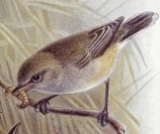
Grey Warbler
Encyclopedia
The Grey Gerygone more commonly known in New Zealand
as the Grey Warbler or Riroriro, is a species of insectivorous
bird in the Acanthizidae
family endemic to New Zealand.
Its natural habitat
is temperate forest
s.
weighing about 6.5 grams this 11 cm long bird is grey-brown (tending to olive green tint) above and has a pale grey face, throat and breast and has an off white abdomen, tinged with yellow. The tail is white underneath and dark brown on top with white tips visible in flight, it also has a distinctive ruby-red eye. The female has similar plumage but is smaller in size. The young are paler with no hint of yellow and have brown eyes. The male's song often starts with a series of three squeaks and builds into a distinctive long plaintive wavering trill that rises and falls. They sing throughout the year but most vigorously when nesting, during spring. More commonly heard than seen.
Their breeding season is from August to January and they usually manage two clutches, but the Shining Cuckoo often parasitises this second clutch leaving a single egg for the warblers to incubate and rear.
New Zealand
New Zealand is an island country in the south-western Pacific Ocean comprising two main landmasses and numerous smaller islands. The country is situated some east of Australia across the Tasman Sea, and roughly south of the Pacific island nations of New Caledonia, Fiji, and Tonga...
as the Grey Warbler or Riroriro, is a species of insectivorous
Insectivore
An insectivore is a type of carnivore with a diet that consists chiefly of insects and similar small creatures. An alternate term is entomophage, which also refers to the human practice of eating insects....
bird in the Acanthizidae
Acanthizidae
The Acanthizidae, also known as the Australasian warblers, are a family of passerine birds which include gerygones, thornbills, and scrubwrens. The Acanthizidae consists of small to medium passerine birds, with a total length varying between 8 and 19 cm. They have short rounded wings, slender...
family endemic to New Zealand.
Its natural habitat
Habitat
* Habitat , a place where a species lives and grows*Human habitat, a place where humans live, work or play** Space habitat, a space station intended as a permanent settlement...
is temperate forest
Forest
A forest, also referred to as a wood or the woods, is an area with a high density of trees. As with cities, depending where you are in the world, what is considered a forest may vary significantly in size and have various classification according to how and what of the forest is composed...
s.
Description
Smaller than the SilvereyeSilvereye
The Silvereye or Wax-eye is a very small passerine bird native to Australia, New Zealand and the south-west Pacific islands of Lord Howe, New Caledonia, Loyalty Islands, Vanuatu, and Fiji...
weighing about 6.5 grams this 11 cm long bird is grey-brown (tending to olive green tint) above and has a pale grey face, throat and breast and has an off white abdomen, tinged with yellow. The tail is white underneath and dark brown on top with white tips visible in flight, it also has a distinctive ruby-red eye. The female has similar plumage but is smaller in size. The young are paler with no hint of yellow and have brown eyes. The male's song often starts with a series of three squeaks and builds into a distinctive long plaintive wavering trill that rises and falls. They sing throughout the year but most vigorously when nesting, during spring. More commonly heard than seen.
Distribution and habitat
Common throughout New Zealand main islands and many off-shore islands, absent from open country and alpine areas. At home in native and exotic forests it may be found almost anywhere there is some tree or shrub cover.Diet
Grey warblers mainly feed upon spiders, insects and their larvae. They are very active, almost never stay still as they move from one perch to perch.Nesting
Grey warblers are unique among New Zealand birds in building a pear-shaped structure with a side entrance near the top. Although the male collects material, the nest itself is constructed by the female from grass, leaves, rootlets and moss, held together with spider web threads. It is constructed anywhere from 2 to 25 feet above the ground, and is lined with feathers and other soft material. It is attached to a twig at the top, but is often also secured at the back or sides well. Although not involved in nest building or incubation, the male helps to feed both nestlings and fledglings. The 3 to 6 eggs, each laid 2 days apart, are pinkish-white with fine reddish-brown speckles all over. The eggs, weighing 1.5 grams are about 17 millimetres long and 12 millimetres wide. Incubation takes about 19 days and the chicks spend another 15 to 19 days in the nest.Their breeding season is from August to January and they usually manage two clutches, but the Shining Cuckoo often parasitises this second clutch leaving a single egg for the warblers to incubate and rear.

